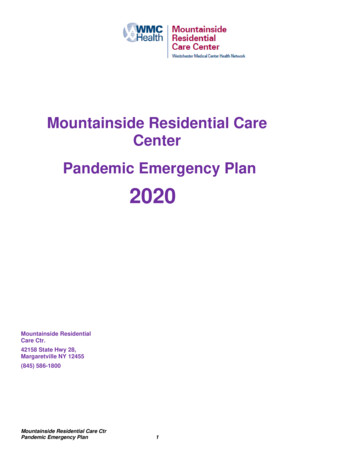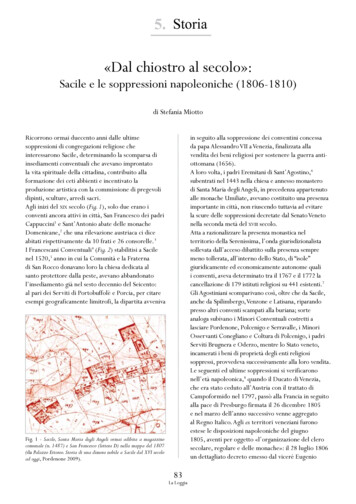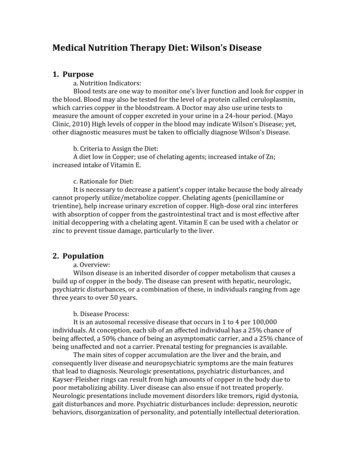
Transcription
Mountainside Residential CareCenterPandemic Emergency Plan2020Template2020Mountainside ResidentialCare Ctr.42158 State Hwy 28,Margaretville NY 12455(845) 586-1800Mountainside Residential Care CtrPandemic Emergency Plan1
InstructionsThe NYSDOH Comprehensive Emergency Management (CEMP) Template is a tool to helpfacilities develop and maintain facility-specific CEMPs. For 2020, Appendix K has been updatedto include guidance and formatted to provide a form to comply with the new requirements ofChapter 114 of the Laws of 2020 for the development of a Pandemic Emergency Plan (PEP).Theplan template is designed to help facilities easily identify the information needed to effectively planfor, respond to, and recover from natural and man-made disasters. All content in this templateshould be reviewed and tailored to meet the needs of each facility.Refer to Part 1 – Instructions for additional information about completion of this template.Refer to Part 3 – Toolkit for supplementary tools and templates to inform CEMP development andimplementation.Mountainside Residential Care Ctr.Pandemic Emergency Plan2
Emergency ContactsThe following table lists contact information for public safety and public health representatives forquick reference during an emergency.Table 1: Emergency Contact InformationOrganizationPhone Number(s)Local Fire Department(845) 586-4419Local Police Department(607) 832-5555Emergency Medical Services 845-586-2631(845) 586-2631Fire Marshal(607) 832-5520Local Office of Emergency Management(607) 832-5600NYSDOH Regional Office (Business Hours)1(607) 832-5600NYSDOH Duty Officer (Business Hours)(866) 881-2809New York State Watch Center (Warning Point)(Non-Business Hours)(518) 292-2200During normal business hours (non-holiday weekdays from 8:00 am – 5:00 pm), contact the NYSDOH Regional Office for your regionor the NYSDOH Duty Officer. Outside of normal business hours (e.g., evenings, weekends, or holidays), contact the New York StateWatch Center (Warning Point).1Mountainside Residential Care Ctr.Pandemic Emergency Plan3
Approval and ImplementationThis Comprehensive Emergency Management Plan (CEMP) has been approved forimplementation by:Christopher EsolaNursing Home AdministratorMountainside Residential Care Ctr.Pandemic Emergency PlanSeptember 1, 20204
Record of ChangesTable 2: Record of ChangesVersion#1.0Mountainside Residential Care Ctr.Pandemic Emergency PlanImplementedByChris Esola, NursingHome Administrator5RevisionDateSeptember 1, 2020Description of ChangeUpdated all ContactInformation
Record of External DistributionTable 3: Record of External DistributionDateRecipient NameSept 15,2020Mountainside Residential Care Ctr.Pandemic Emergency Plan6Recipient OrganizationFormatNumber ofCopiesMountainsideResidential– WebSiteDigital(Email)1
Background1.1 IntroductionTo protect the well-being of residents, staff, and visitors, the following all-hazards ComprehensiveEmergency Management Plan (CEMP) has been developed and includes considerationsnecessary to satisfy the requirements for a Pandemic Emergency Plan (PEP). Appendix K of theCEMP has been adjusted to meet the needs of the PEP and will also provide facilities a form topost for the public on the facility's website, and to provide immediately upon request. The CEMPis informed by the conduct of facility-based and community-based risk assessments and predisaster collaboration with: Margaretville Hospital, HealthAlliance of the Hudson Valley, TheGrand @ Robinson Terrace, St. Joseph’s Place, Schervier Pavilion, local EMR Officials and theNYS Department of Health.This CEMP is a living document that will be reviewed annually, at a minimum, in accordance withSection 7: Plan Development and Maintenance.1.2 PurposeThe purpose of this plan is to describe the facility’s approach to mitigating the effects of, preparingfor, responding to, and recovering from natural disasters, man-made incidents, and/or facilityemergencies.Mountainside Residential Care Ctr.Pandemic Emergency Plan7
Figure 1: Four Phases of Emergency ManagementPrevention ofanticipatedemergenciesor minimizingtheir impactPreparation toaddress ecovering in theshort,intermediate, andlong-term from anemergencyRespondingefficiently andsafely to anemergency1.3 ScopeThe scope of this plan extends to any event that disrupts, or has the potential to significantlydisrupt, the provision of normal standards of care and/or continuity of operations, regardless ofthe cause of the incident (i.e., man-made or natural disaster).The plan provides the facility with a framework for the facility’s emergency preparedness programand utilizes an all-hazards approach to develop facility capabilities and capacities to addressanticipated events.Mountainside Residential Care Ctr.Pandemic Emergency Plan8
1.4 Situation1.4.1 Risk Assessment2The facility conducts an annual risk assessment to identifywhich natural and man-made hazards pose the greatest riskto the facility (i.e., human and economic losses based on thevulnerability of people, buildings, and infrastructure).The facility conducted a facility-specific risk assessment inDecember 2019 and determined the following hazards mayaffect the facility’s ability to maintain operations before, during,and after an incident: Elevator Service Snowstorm, Blizzard or Ice Storm Tornado Earthquake Extreme Temperatures Epidemic/Pandemic Landslide Biological and/or Chemical Terrorism Missing Person – (including) Adult Abduction Generator Failure Fire Suppression Loss of Water Pumps Building DamageThis risk information serves as the foundation for the plan—including associatedpolicies, procedures, and preparedness activities.The Hazard Vulnerability Analysis (HVA) is the industry standard for assessing risk to healthcare facilities. Facilities may rely on a community-basedrisk assessment developed by public health agencies, emergency management agencies, and Health Emergency Preparedness Coalition or inconjunction with conducting its own facility-based assessment. If this approach is used, facilities are expected to have a copy of the community-basedrisk assessment and to work with the entity that developed it to ensure that the facility’s emergency plan is in alignment.Mountainside Residential Care Ctr.Pandemic Emergency Plan9
1.4.2 Mitigation OverviewThe primary focus of the facility’s pre-disaster mitigation efforts is to identify the facility’s level ofvulnerability to various hazards and mitigate those vulnerabilities to ensure continuity of servicedelivery and business operations despite potential or actual hazardous conditions.To minimize impacts to service delivery and business operations during an emergency, the facilityhas completed the following mitigation activities: Development and maintenance of a CEMP; Procurement of emergency supplies and resources; Establishment and maintenance of mutual aid and vendor agreements to providesupplementary emergency assistance; Regular instruction to staff on plans, policies, and procedures; and Validation of plans, policies, and procedures through exercises.3For more information about the facility’s fire prevention efforts (e.g., drills), safety inspections, andequipment testing, please refer to the Fire Drill Book.1.5 Planning AssumptionsThis plan is guided by the following planning assumptions:3 Emergencies and disasters can occur without notice, any day, and on any shift. Emergencies and disasters may be facility-specific, local, regional, or state-wide. Local and/or state authorities may declare an emergency. The facility may receive requests from other facilities for resource support (supplies,equipment, staffing, or to serve as a receiving facility). Facility security may be compromised during an emergency. The emergency may exceed the facility’s capabilities and external emergency resourcesmay be unavailable. The facility is expected to be able to function without an influx ofoutside supplies or assistance for 72 hours. Power systems (including emergency generators) could fail. During an emergency, it may be difficult for some staff to get to the facility, or alternately,they may need to stay in the facility for a prolonged period of time.Refer to the “Training and Exercises” section of this plan for additional information about pre-incident trainings and exercises.Mountainside Residential Care Ctr.Pandemic Emergency Plan10
2 Concept of Operations2.1Notification and Activation2.1.1 Hazard IdentificationThe facility may receive advance warning about an impending natural disaster (e.g., hurricaneforecast) or man-made threat (e.g., law enforcement report), which will be used to determine initialresponse activities and the movement of personnel, equipment, and supplies. For no-noticeincidents (e.g., active shooter, tornado), facilities will not receive advance warning about thedisaster, and will need to determine response activities based on the impact of the disaster.The Incident Commander may designate a staff member to monitor evolving conditions, typicallythrough television news, reports from government authorities, and weather forecasts.All staff have a responsibility to report potential or actual hazards or threats to their directsupervisor.2.1.2 ActivationUpon notification of hazard or threat—from staff, residents, orexternal organizations—the senior-most on-site facility officialwill determine whether to activate the plan based on one ormore of the triggers below: The provision of normal standards of care and/orcontinuity of operations is threatened and couldpotentially cause harm.The facility has determined to implement a protective action. The facility is serving as a receiving facility. The facility is testing the plan during internal and external exercises (e.g., fire drills).If one or more activation criteria are met and the plan is activated, the senior-most on-site facilityofficial—or the most appropriate official based on the incident—will assume the role of “IncidentCommander” and operations proceed as outlined in this document.Mountainside Residential Care Ctr.Pandemic Emergency Plan11
2.1.3 Staff NotificationOnce a hazard or threat report has been made, an initial notification message will be disseminatedto staff in accordance with the facility’s communication plan.Department Managers or their designees will contact on-duty personnel to provide additionalinstructions and solicit relevant incident information from personnel (e.g., status of residents,status of equipment).Once on-duty personnel have been notified, Department Managers will notify off-duty personnelif necessary and provide additional guidance/instruction (e.g., request to report to facility).Department personnel are to follow instructions from Department Managers, keep lines ofcommunication open, and provide status updates in a timely manner.2.1.4 External NotificationDepending on the type and severity of the incident, the facility may also notify external parties(e.g., local office of emergency management, resource vendors, relatives and responsible parties)utilizing local notification procedures to request assistance (e.g., guidance, information,resources) or to provide situational awareness.The NYSDOH Regional Office is a mandatory notification recipient regardless of hazard type,while other notifications may be hazard-specific. Table 4 provides a comprehensive list ofmandatory and recommended external notification recipients based on hazard type.Mountainside Residential Care Ctr.Pandemic Emergency Plan12
Active Threat4Blizzard/Ice StormCoastal StormDam FailureWater DisruptionEarthquakeExtreme ColdExtreme HeatFireFloodCBRNE5Nfectious DiseaseIT/Comms FailurePower OutageTornadoWildfireNYSDOH RegionalOffice6MMMMMMMMMMMMMM MMMMFacility SeniorLeaderM M Local EmergencyManagementR M Local LawEnforcement R Local Fire/EMS R M Off Duty Staff M Relatives andResponsibleParties M Resource Vendors M Authority HavingJurisdiction M RegionalHealthcare FacilityEvacuation Center R Notification RecipientM MandatoryR RecommendedLocal lideExample HazardTable 4: Notification by Hazard TypeMHealthAlliance ofHV“Active threat” is defined as an individual or group of individuals actively engaged in killing or attempting to kill people in a populated area. Exampleattack methods may include bombs, firearms, and fire as a weapon.5 “CBRNE”refers to “Chemical, Biological, Radiological, Nuclear, or Explosive”To notify NYSDOH of an emergency during business hours (non-holiday weekdays from 8:00 am – 5:00 pm), the IncidentCommander will contact the NYSDOH Regional Office @ (607) 832-5600. Outside of normal business hours (e.g., evenings,weekends, or holidays), the Incident Commander will contact the New York State Watch Center (Warning Point) at 518- 292-2200.The Watch Command will return the call and will ask for the type of emergency and the type of facility (e.g. hospital, nursing home,adult home) involved. The Watch Command will then route the call to the Administrator on Duty, who will assist the facility withresponse to the situation.Mountainside Residential Care Ctr.Pandemic Emergency Plan13
2.2 Mobilization2.2.1 Incident Management TeamUpon plan activation, the Incident Commander will activate some or all positions of the IncidentManagement Team, which is comprised of pre-designated personnel who are trained andassigned to plan and execute response and recovery operations.Incident Management Team activation is designed to beflexible and scalable depending on the type, scope, andcomplexity of the incident. As a result, the IncidentCommander will decide to activate the entire team or selectpositions based on the extent of the emergency.Table 5 outlines suggested facility positions to fill each of theIncident Management Team positions. The most appropriateindividual given the event/incident may fill different roles asneeded.Table 5: Incident Management Team - Facility Position CrosswalkIncident acility Position TitleDescriptionNursing Home Administrator,Director of Nursing, Engineering,Staff Education, NursingSupervisor(s)Leads the response and activates andmanages other Incident ManagementTeam positions.Marketing, Executive Assistant@MRCC, Director of Resident &Family Svcs., AdmissionsCoordinatorEngineering Director, SecuritySafety OfficerInfection Control, RNs, LPNsOperationsSection ChiefMountainside Residential Care Ctr.Pandemic Emergency Plan14Provides information and updates tovisitors, relatives and responsibleparties, media, and externalorganizations.Ensures safety of staff, residents, andvisitors; monitors and addresseshazardous conditions; empowered tohalt any activity that poses an immediatethreat to health and safety.Manages tactical operations executed bystaff (e.g., continuity of resident services,administration of first aid).
-Incident PositionPlanningSection ChiefLogisticsSection ChiefFinance/AdminSection ChiefFacility Position TitleDescriptionNursing Home Administrator,Director of Nursing, MDSCoordinator, Director ofResident & Family Services,Staffing CoordinatorCollects and evaluates information tosupport decision-making and maintainsincident documentation, includingstaffing plans.Purchasing Department,Admissions Coordinator, Directorof Hospitality, HIM ClerkLocates, distributes, and storesresources, arranges transportation, andmakes alternate shelter arrangementswith receiving facilities.Director of Human Resources,FinanceMonitors costs related to the incidentwhile providing accounting, procurement,time recording, and cost analyses.If the primary designee for an Incident Management Team position is unavailable, Table 6identifies primary, secondary, and tertiary facility personnel that will staff Incident ManagementTeam positions.While assignments are dependent upon the requirements of the incident, available resources,and available personnel, this table provides initial options for succession planning, including shiftchanges.Incident PositionIncident CommanderTable 6: Orders of SuccessionPrimarySuccessor 1Nursing HomeAdminSuccessor 2Director of NursingMDS CoordinatorPublic Information OfficerMarketingDirector of Resident& Family Svcs.AdmissionsSafety OfficerEngineerSecurityMaintenanceOperations Section ChiefNurse PractitionerInfection ControlRN/LPNPlanning Section ChiefNursing HomeAdministratorDirector of NursingMDS CoordinatorLogistics Section in Section ChiefHR DirectorFinanceMountainside Residential Care Ctr.Pandemic Emergency Plan15
2.2.2 Command CenterThe Incident Commander will designate a space, e.g., facility conference room or other largegathering space, on the facility premises to serve as the centralized location for incidentmanagement and coordination activities, also known as the “Command Center.”The designated location for the Command Center is Club Med and the secondary/back-uplocation is the Staff Education Office unless circumstances of the emergency dictate thespecification of a different location upon activation of the CEMP, in which case staff will benotified of the change at time of activation.2.3 Response2.3.1 AssessmentThe Incident Commander will convene activated Incident Management Team members in theCommand Center and assign staff to assess designated areas of the facility to account forresidents and identify potential or actual risks, including the following: Number of residents injured or affected;Status of resident care and support services;Extent or impact of the problem (e.g., hazards, life safety concerns);Current and projected staffing levels (clinical, support, and supervisory/managerial);Status of facility plant, utilities, and environment of care;Projected impact on normal facility operations;Facility resident occupancy and bed availability;Need for protective action; andResource needs.2.3.2 Protective ActionsRefer to Annex A: Protective Actions for more information.2.3.3 StaffingBased on the outcomes of the assessment, the Planning Section Chief will develop a staffing planfor the operational period (e.g., remainder of shift). The Operation Section Chief will execute thestaffing plan by overseeing staff execution of response activities. The Finance/AdministrationSection Chief will manage the storage and processing of timekeeping and related documentationto track staff hours.Mountainside Residential Care Ctr.Pandemic Emergency Plan16
2.4 Recovery2.4.1 Recovery ServicesRecovery services focus on the needs of residents and staff and help to restore the facility’s predisaster physical, mental, social, and economic conditions.Recovery services may include coordination with government, non-profit, and private sectororganizations to identify community resources and services (e.g., employee assistance programs,state and federal disaster assistance programs, if eligible). Pre-existing facility- and communitybased services and pre-established points of contact are provided in Table 8.Table 7: Pre-Identified Recovery ServicesServiceNYS Department of HealthDescription of ServicePoint(s) of ContactAssists with staffing,supplies, Mental HealthSupport (EAP)(845) 334-2762 EAP(914) 216-7733 Covid Relief(* through the NYS DOH)FEMALeading AgeEmergency ManagementResources Provided,including housing(800) 621-3362 orLong Term CareAdvocateTel (518) 867-8854Email:AskIA@fema.dhs.govOngoing recovery activities, limited staff resources, as well as the incident’s physical and mentalhealth impact on staff members may delay facility staff from returning to normal job duties,responsibilities, and scheduling.Resuming pre-incident staff scheduling will require a planned transition of staff resources,accounting for the following considerations: Priority s
Sep 01, 2020 · Mountainside Residential Care Ctr. Pandemic Emergency Plan 5 Record of Changes Table 2: Record of Changes Version # Implemented By Revision Date Description of Change 1.0 Chris Esola, Nursing Home Admini











